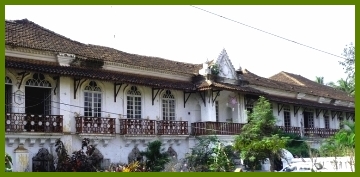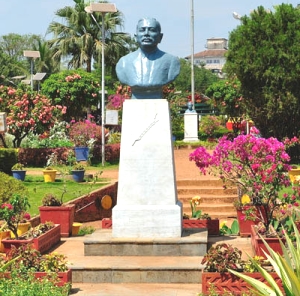The Tilak of Goa
 If you stop by the village of Chandor in Salcete, Goa, today, you won’t see any trace of the swagger of its heyday when it used to be the capital city of the Kadambas and a thriving centre of trade and commerce. What you’ll see is a serene rural landscape dotted by a clutch of stately colonial mansions which were once the dwellings of the aristocracy. But the grandest of these opulent landmarks is the two-storey Braganza House, stretching along all of 400 ft., and nestling amidst decorative palms and flowering shrubs just a few metres down the road from Chandor’s 17th century Nossa Senhora de Belem Church.
If you stop by the village of Chandor in Salcete, Goa, today, you won’t see any trace of the swagger of its heyday when it used to be the capital city of the Kadambas and a thriving centre of trade and commerce. What you’ll see is a serene rural landscape dotted by a clutch of stately colonial mansions which were once the dwellings of the aristocracy. But the grandest of these opulent landmarks is the two-storey Braganza House, stretching along all of 400 ft., and nestling amidst decorative palms and flowering shrubs just a few metres down the road from Chandor’s 17th century Nossa Senhora de Belem Church.
The most significant feature of this iconic mansion is not that more than 400 years later it is still inhabited by descendants of the original owners, or that it has two sprawling, ornately furnished wings, an east wing occupied by the Pereira Braganza side of the family, and a west wing, occupied by the Menezes Braganza side, but that it was the house of a great son of Goa. A luminary, who, because of the dexterity with which he wielded the power of his pen to spark off the anti-colonialist movement in Goa, came to be referred to by people in the rest of India as “the Tilak of Goa”. This outstanding journalist, politician and social activist was Luis de Menezes Braganza.
Co-founder of Goa’s oldest newspaper –The Herald
Luis de Menezes Braganza (also spelt as Luis de Menezes Bragança) was born as Luis de Menezes in Chandor on 15 January 1878, into a wealthy Chardo family. His mother came from another distinguished family from the same village – the Braganzas, whose ancestors were an educated and wealthy Hindu family named Desai who got converted to Christianity after the Jesuits came to Goa in the mid-16th century. Later, somewhere in the 19th century, because of their dedicated services to the government of Portugal, the family was conferred with the name of the last royal house of Portugal, Braganza.
Luis’s maternal grandfather Francis Xavier Braganza didn’t have any sons. So, he agreed to appoint him as his heir provided that he adopted Braganza as his own surname. And that is how, in contrast to the Portuguese custom of the paternal surname following the maternal one, Luis added his maternal name Braganza to his original name and became Luis de Menezes Braganza.
Soon after Luis completed his education at the Lyceum in Panjim, it became evident that he was an excellent writer. It was not surprising therefore when he decided to make a career as a journalist. He was barely 22 years old when in 1900, together with another reputed Goan writer, Professor Messias Gomes, he established the first Portuguese language daily in Goa – O Heraldo. The newspaper was transformed into an English daily, The Herald, in 1987, and is currently one of the leading English papers in Goa.
Early champion of a secular, independent Goa
 In 1911, Menezes Braganza started yet another paper O Debate (The Debate), and used his sparkling wit and journalistic skills to jolt the political consciousness of his fellow men. A few years later, he founded the Portuguese daily Diario de Noite (The Evening News) that brought news of the freedom movement underway in the rest of India to the Goan people, and covered cultural issues as well. He also regularly contributed insightful and hard-hitting articles to the Marathi-Portuguese bilingual periodical Pracasha (The Light), propounding freedom from suppression and upholding the right to freedom of expression. So even as Lokmanya Tilak was urging Indians to fight for freedom through the pages of Kesari and Maratha, Luis de Menezes Braganza was fighting for the cause of self-determination, secularism, and independence through his fiery writings in Goa. A prominent journalist of his times, Menezes Braganza was one of the few Goan aristocrats to staunchly oppose Portuguese rule in Goa.
In 1911, Menezes Braganza started yet another paper O Debate (The Debate), and used his sparkling wit and journalistic skills to jolt the political consciousness of his fellow men. A few years later, he founded the Portuguese daily Diario de Noite (The Evening News) that brought news of the freedom movement underway in the rest of India to the Goan people, and covered cultural issues as well. He also regularly contributed insightful and hard-hitting articles to the Marathi-Portuguese bilingual periodical Pracasha (The Light), propounding freedom from suppression and upholding the right to freedom of expression. So even as Lokmanya Tilak was urging Indians to fight for freedom through the pages of Kesari and Maratha, Luis de Menezes Braganza was fighting for the cause of self-determination, secularism, and independence through his fiery writings in Goa. A prominent journalist of his times, Menezes Braganza was one of the few Goan aristocrats to staunchly oppose Portuguese rule in Goa.
After joining politics, Luis de Menezes Braganza was elected to high positions in different organisations. He was President of the Municipality of Ilhas, President of the Provincial Congress of Goa, leader of the Opposition in the Government Council and Legislative Assembly, and was appointed as Portuguese India’s delegate to the Colonial Conference in Lisbon in 1924. Besides, he wrote extensively, some of his major works being ‘The Comunidades and the Cult’ (1914), ‘The Castes’ (1915), ‘India and her Problems’ (1924), ‘Tourism in Goa’ (1927), and ‘About an Idea’ (1928). Menezes Braganza was also a member of the prestigious cultural organisation, Instituto Vasco da Gama.
With his famous 1914 essay “Why Konkani?” Menezes Braganza began a movement in defence of Konkani and received active support from Goan intellectuals. He campaigned for imparting primary education in Konkani and accused the Portuguese government of not supporting the growth and development of Konkani because of their obsession with the denationalization of the Goan people.
In 1930, after the declaration of the racist Acto Colonial (Colonial Act) by the Portuguese Government, he made a powerful appeal on the floor of the Legislative Council in Panjim for passing a resolution advocating the right of the Goan people to self-determination and tabled a motion that emphasized that the people’s right to guide their own destinies was “the birth right of their organic essence”.
However, Luis de Menezes Braganza’s vociferous demand for autonomy for Goa was ruthlessly turned down by Salazar’s Estado Novo regime and his newspapers were closed down. When this outspoken nationalist died on 10 July 1938, Portuguese troops were stationed around his grave to prevent any homage by the Goan public and avert the eruption of any nationalist protests in Goa.
Preserving the memory of a worthy son
After Goa’s liberation, the Instituto Vasco Da Gama in Panjim, of which Luis de Menezes Braganza was once a member, was re-named as the Institute Menezes Braganza in 1963. Today, you’ll see a bust of this illustrious Goan in the Municipal Garden in Margao, and another installed in a garden near the North Goa Collectorate in Panjim. But, I think the best way to preserve the memory of courageous super-heroes is to keep the flame of their memories burning in our hearts and then pass it on to our children and grandchildren.
Viva Goa!

Pingback: When Portuguese Soldiers Surrounded the Grave of ‘The Greatest of all Goans’ - The Better Planet